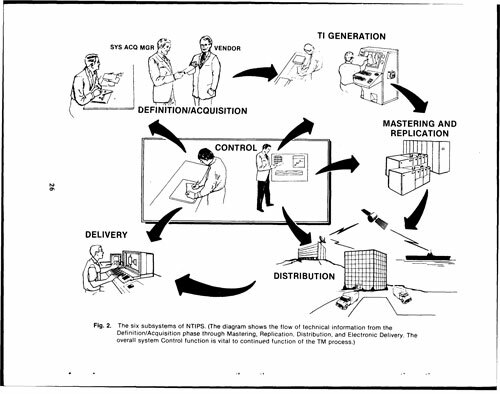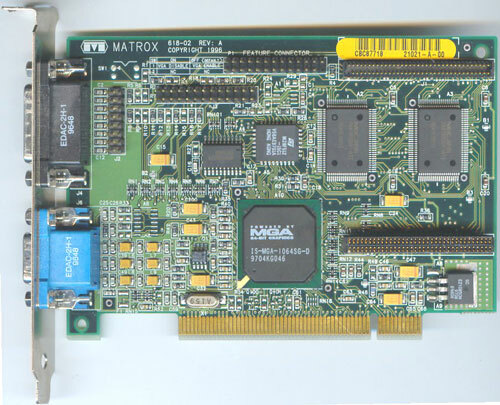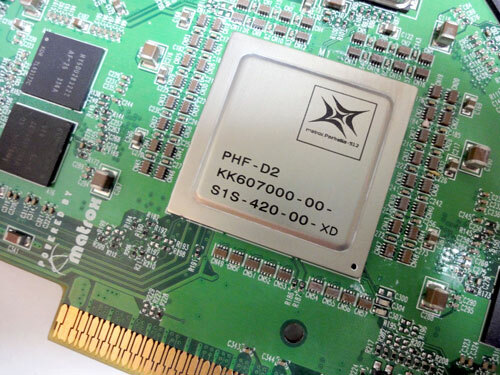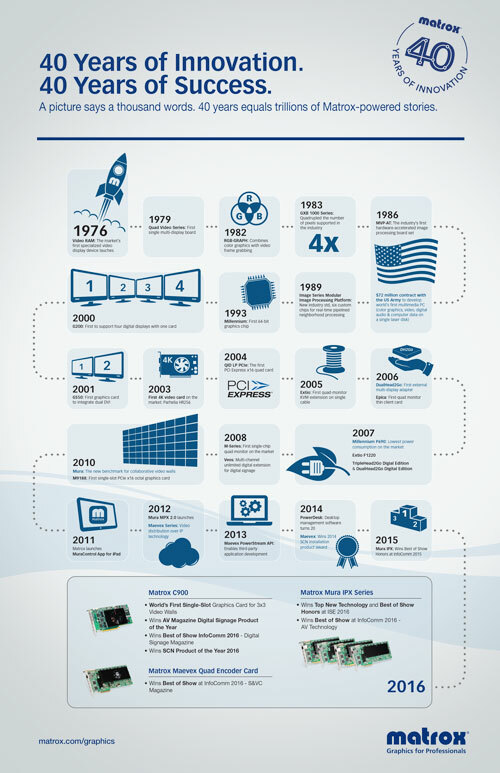Today in Tedium: If you use computers with any level of seriousness and focus on horsepower, you’re probably aware that one of the most important components of the computer is the graphics processing unit, or GPU. A fast GPU is a must for video processing and other image-heavy productivity tasks, but GPUs are really known for their ability to push the limits on popular 3D-driven games. There’s an obsession with this kind of performance, in fact—hence why folks can’t stop talking about whatever Nvidia and AMD are putting into their graphics chips next. But two decades ago, these two companies had a competitor—and that competitor did something unusual and surprising: The graphics card maker Matrox decided to simply drop out of the market for consumer graphics entirely—a move that seemingly would have sunk any other company. So what happened to Matrox? Well, let me tell you! Today’s Tedium talks Matrox, the misunderstood graphics firm that could never quite get 3D right. — Ernie @ Tedium
You won’t hate insurance anymore after trying Lemonade.
Insurance is defined by Urban Dictionary as “A business that involves selling people promises to pay later that are never fulfilled.“ Lemonade was created to change that, using AI to simplify the entire process. Lemonade takes a flat fee, pay claims super fast, and give back what’s left to causes you care about. No more gobbledigook, no more forms or phone calls—get insured with Lemonade in 90 secs, starting at $5/month.
A tech demo for the Matrox G200 graphics card.
Why Matrox is such an interesting company from a historic perspective
Now, I’ve covered this era of the computer graphics field before—particularly with a lengthy piece about 3Dfx, a firm that was arguably more influential to the computer industry in the long run than Matrox.
So why does Matrox deserve a similarly long piece? Simply put, I think a lot of people who were really into tech stopped following it at some point, much in the same way Creative faded from view when sound cards went from necessity to nice-to-have.
I, for one, was inspired to write this piece based on a YouTube clip on a channel called Budget-Builds Official titled “The card that KILLED … Matrox.”
It’s a perfectly fine clip, and has a lot of really interesting details in it. But you would think that, based on its title alone, there’d be nothing left of Matrox, this company that was steamrolled by Nvidia and ATI on the road to irrelevance.

The Matrox company pool.
Imagine my surprise when I did a look around and found that Matrox was not only still alive, but it appeared to be a thriving company with a whole slew of different product lines, a clearly robust graphics card business even in the modern day, and its own company pool with the company’s friggin’ Bauhaus-type logo in the middle.
A big reason for this disparity between perception and reality isn’t merely because the company is based in Quebec, in a suburb of Montreal far away from Silicon Valley. Rather, I think it comes down to something of a perception issue that results from the way that we talk about modern computer graphics.
This is to say that, if a graphics company isn’t focused on polygons and high frame rates in Overwatch or Fortnite, with a goal of hitting warp speed on maxed-out graphics cards, traditional consumers don’t really give a hoot. That’s all framing, when it comes down to it—and while there probably needs to be more than two big companies making graphics chips for this market, the perception of the gaming market shaping the graphics card market is hard to shake.
But nearly two decades ago, Matrox just decided that hamster wheel wasn’t for them, and instead focused on an area that it could really excel at: 2D computer graphics that could be displayed on numerous screens at once.
In fact, Matrox appears to care so little about competing with Nvidia and AMD on the graphics front that it’s all but washed away the portion of its history where it actually was focused on that market. A 40th-anniversary graphic, produced by Matrox’s marketing team in 2016, doesn’t even bother to mention the company’s time in the consumer 3D graphics market, despite the fact it’s likely what the average consumer (admittedly an older consumer) might remember Matrox for.
In fact, there’s an uncomfortable gap of seven years, lasting from 1993 to 2000, where there are no entries at all, despite the fact that this was the primary period in which Matrox was focused on 3D graphics. Meanwhile, the company felt that “first graphics card to integrate dual DVI” deserved a place in the timeline.
Was Matrox embarrassed by its time in the consumer graphics market? Or does the company just feel like there’s more to talk about in its corporate history than the fact that it tried and failed to cozy up to the gaming market?
Let’s talk about that history a little bit and figure out what we can learn.
“When we started, there was no venture capital. What helped us is that we picked a product to develop that we were able to sell within six months. We kind of bootstrapped and grew slowly in the beginning, not necessarily by choice.”
— Lorne Trottier, the cofounder of Matrox, discussing with The Montrealer how the company got its start. The firm, which he started with business partner Branko Matic in 1976 (the name comes from their names: “Ma” for Matic, “tro” for Trottier, and an x, standing for “excellence,” thrown in for good measure), predates fellow Canadian company ATI, later acquired by AMD, by about a decade, and current graphics processing giant Nvidia by about 15 years. Matrox has been around so long that it got its start developing hardware for the S-100 bus, an expansion bay commonly used in early Altair computers, and its ALT-256, first released in 1978, is one of the first dedicated graphics cards ever produced.

An image from a military document describing the distribution process used in the electronic information delivery system, or EIDS. Matrox was the primary vendor for this process.
The pivotal decision that showed where Matrox’s true passions lie
As a company, Matrox quickly gained a lot of momentum upon its launch in the 1970s—according to a 1979 classified ad in The Gazette, Montreal’s English-language newspaper, the company already had 50 employees and was claiming growth of 200 percent per year.
The company had something of a quiet momentum during its first decade, as it helped to create methods for expanding the possibilities of computer graphics. It slowly expanded as it gained more clients, but didn’t have a true breakout moment at first.
That came in 1986, when the U.S. Army awarded a contract to finance the creation of a multimedia computer system for training soldiers. It was an endeavor the military branch had been looking into fulfilling for about a decade, and the Army needed thousands of machines (possibly tens of thousands) for what it called the electronic information delivery system, or EIDS.
A number of multinational companies reached out with their bids, but Matrox somehow turned out to be the vendor that won the big contract.
According to a 1986 Gazette article, the seeds for the company’s success with the U.S. Army came about after a buyer with supposed ties to the CIA wanted a device that could produce information to store on a video disc.
“What he was trying to do flabbergasted me,” Trottier told the newspaper. But the company built out the video disc technology anyway—only to find that, after it had done so, the firm went out of business. For years, Matrox had this technology just sitting around, waiting for an opportunity to fall into use.
That opportunity turned out to be EIDS.
It was an impressive victory against some of the world’s largest technology companies, including Sony, and it was at the time believed that the Army’s technology could prove game-changing enough that it would give Matrox a long-term upper hand amid a new standard.
“The contract takes a lot of uncertainty out of the interactive video industry,” Raymond Fox of the Society for Applied Learning Technology told The New York Times in 1987. “With EIDS, everybody knows what the standards are and how to move forward.”
It, of course, didn’t work out that way, but it did give the company access to a $72 million contract, which likely buoyed the company for years afterwards and gave it a financial and strategic advantage during the early multimedia era.
And there’s probably a point to be made in the other direction here: The company’s ability to win a contract like this—even in spite of broader competition from way bigger players—likely helped it survive as it moved outside of the mainstream GPU market.
$850M
The size of Matrox’s computer-graphics business in 1997. That represents a jump from just $30 million five years prior. The company, as a whole, made around $1 billion in revenue that year, and had a headcount that topped 1,000 employees. That high point, ultimately, would not last.

The much-derided Matrox Mystique graphics card. (Wikimedia Commons)
Why Matrox couldn’t keep up in the big-box graphics game
So what can be said of Matrox’s trajectory during the period consumers were probably most likely to run into its products, that being during the late ’90s?
Matrox was never in a market that was particularly light with competition, of course, but 3Dfx’s early steps into the market, as well as the increasing ambitions of Sony and Nintendo in the console market, highlighted that the consumers were increasingly interested in 3D graphics—an area that Matrox had dipped its toes in previously with the Matrox Impression, a 3D card targeting the CAD market.
All of a sudden, though, the momentum was swinging hard towards consumers. It was as if the market went from playing solitaire to playing Quake overnight.
At first, this was to Matrox’s benefit—as it opened up interest from the broader computer market in higher-end video cards, an area where it was dominant in the early 1990s. The company had a longer track record than nearly all of its competition and a long history of well-received cards—naturally, they were in a position to maintain a pole position.
But Matrox faced challenges in keeping up with the shift to a third dimension. The company’s marketing was never to the level of its hipper competition, and the Matrox Mystique, the company’s first card specifically targeting the gaming market (complete with jester on the box, for some reason), received not-so-great reviews, in part because the card was mostly optimized for 2D performance but just happened to include some 3D capabilities. The company reportedly decided to skip out on some of the basics of 3D rendering in favor of performance.
“Matrox’s philosophy is that nothing should compromise frame rate, so they chose to forego features that could bog down frame rate,” Computer Gaming World wrote of the card.
This led to some notably horrible 3D rendering quality, even for 1996. It was frequently called the “Matrox Mistake,” or more colorfully, the “Matrox Mystake.”
“Want a card without those inessentials like antialiasing, or filtering? Try this,” a one-star review from Next Generation stated.
Matrox suddenly found itself in an enthusiast-driven consumer market focused on a greatly demanding task, and it was ill-equipped for the change. There were plenty of reasons for this, not all of which were hardware-related: A 1997 Gazette column noted that the company struggled to get enough engineering talent that was willing to work in the bilingual Montreal area, which was still facing political instability, due to Quebec’s citizens nearly passing a 1995 referendum that would have separated it from Canada.
“Unfortunately, it’s no longer possible to find enough qualified engineers in Matrox’s specialized field who are willing to live in Montreal,” columnist Jay Bryan wrote, which meant the company was having to create research and development facilities in other parts of North America, including Florida and Toronto.
This added pressure on research and development meant that a good 1997 turned into a not-so-good 1998 for Matrox, as the company missed an important window for coming out with its G200 graphics chip. That meant original equipment manufacturers (OEMs) like Dell, Compaq, and Gateway went with other manufacturers—particularly ATI Technologies, a fellow Canadian firm whose market share surged that year.
According to statistics published in The Gazette in February of 1999, Matrox’s global market share fell from 20 percent to 10 percent between 1997 and 1998; ATI surged from 29 percent to 37 percent. (It could have been worse; fellow competitor S3 Graphics fell from 33 percent to 18 percent over that same period.)
“This industry is extremely competitive and unforgiving of companies that don’t deliver the right product at the right time,” Trottier said.
But the biggest problem Matrox faced was that it was releasing cards clearly intended for a type of market that neither the media nor consumers were really focused on—which meant that its cards inevitably created market confusion.
A great example of this is the late-era Matrox Millennium G550, the subject of the video by Budget Builds-Official I mentioned earlier. At the point the card came out in 2002, the company was clearly trying to focus on the business market, effectively building cards for a middle-ground market along the lines of what Intel’s integrated graphics sector aims for today. But gamers had hyped themselves up for a Matrox card that was great at 3D graphics—and when they didn’t get that, Matrox suffered.
And even when the company was trying for gamers, it couldn’t keep up. The Matrox Parhelia, released in 2002, has an impressive demo that shows how far Matrox’s technology had come by that point.

The Matrox Parhelia’s main chip. (Wikimedia Commons)
“The Matrox Parhelia is Matrox’s best effort in the 3D graphics market to date,” a 2002 AnandTech review went. “It offers tangible features, the highest performance Matrox has ever been able to provide and a good set of drivers just out of the box.”
The problem is, its Ontario-based neighbor, ATI, was also innovating quickly, and Nvidia had started to become a real force by this point, and whatever Matrox was selling would quickly get outpaced. “Matrox can’t possibly compete with this,” the review continued, noting the advantage its competitors had on the drivers front.
Ultimately, the company just gave up on the consumer graphics market entirely—probably for the best.
Sometimes, the best thing a company can do to ensure its long-term survival is to focus on the blue water all around them, rather than simply fixating on the port where all the boats seemingly are.
And that’s because there are often boats everywhere that could also use a little push—even though they don’t get nearly as much notice outside of the harbor.
(I know the Blue Ocean Strategy involves sharks, not boats, but let me have my metaphor.)
This is a strategy that has defined the basic approach of a lot of companies over the years, most notably Nintendo, but it’s also an apt descriptor of how Matrox has treated its focus in recent years.

The history of Matrox, minus that whole 3D graphics era. (via the Matrox website)
Going back to the 40th anniversary infographic I pointed out earlier, you will see that much of the graphic focuses on things that involve multiple screens, high-resolution screens, or low-power-consumption chips. Matrox was the first company to come out with a graphics card capable of 4K video—and it did so in 2003, at least a decade before anyone actually cared about 4K video as a phenomenon. (That graphics card, the Parhelia, was a very capable 3D card, but the graphic doesn’t mention that!)
In his 2017 interview with The Montrealer, Trottier admitted the company “kind of flamed out” in the midst of its pursuit of market share in the graphics card industry. But the firm never lost its footing and maintains three separate divisions, each focused on different aspects of computer imaging. Much like Nvidia puts its energy toward connected cars and artificial intelligence, Matrox has a lot of focus areas beyond the consumer market.
Much in the way the company found its true calling after the U.S. Army came knocking, it remains a firm that best fits into the vendor mindset.
“Today, we have three basic areas of strength,” Trottier said. “With computer graphics, we’re strong in display walls and public information displays. With television production, when you watch any sports on the nightly news, sports or election results, our cards are in the bowels of what you see. We’re also strong in machine vision. The latest flavor there is deep learning and we’re getting into that via the algorithms we’re developing.”
(Trottier, side note, is a major philanthropist in the Montreal area these days: A building at McGill University that houses the engineering and computer science departments is named for him.)
Matrox these days specializes in hardware for edge cases or niche uses, particularly when it comes to the number of monitors used. It, for example, sells a $650 video card that can display to six separate screens at once. Perhaps the closest the company has gotten to the consumer market since the early 2000s is in the form of its Head2Go series, a series of multi-display adaptors sold for either two monitors or three.

This 72-screen monstrosity, located at the Munich airport, is powered by Matrox’s multi-screen technology.
If you’ve ever walked in an airport and looked at a six-screen (or more) digital sign setup showing the current arrivals and departures being updated in real-time, odds are good that that fewer computers than you think are involved in powering all those screens—likely with Matrox technology splitting out all those signals.
To put this all another way, just because we live in a world where graphics technology is often talked about in a couple of mindsets doesn’t mean that those are the only settings. There are many, many more—and you might find Matrox in more than a few of them.
Just a little food for thought for your next game of Fortnite.
--
Find this one a fascinating read? Share it with a pal! And thanks again to our sponsor Lemonade for giving us a leg up today. See you next time!






